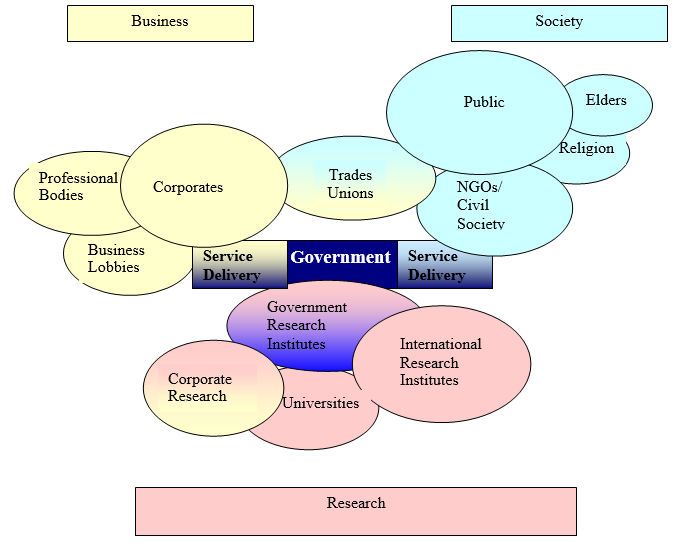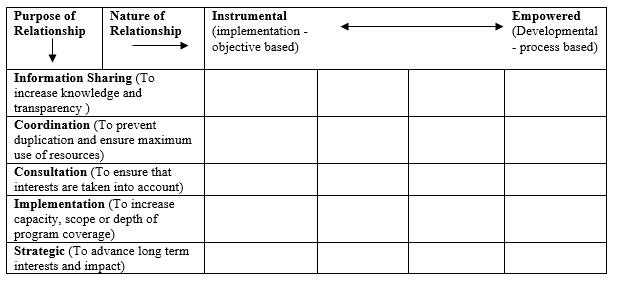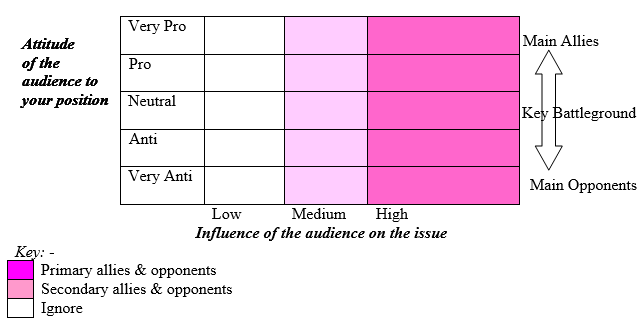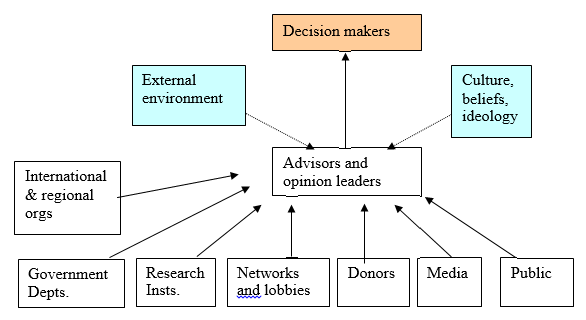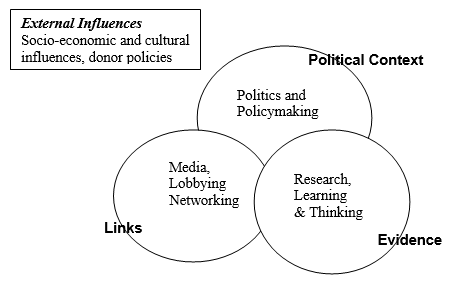
9. Force Field Analysis

Category:
Recommended
Description and Purpose:
Force field analysis is a management tool developed by social scientist Kurt Lewin for diagnosing situations. It is also an excellent tool to use in assessing the driving and restraining forces of an advocacy issue. This is necessary in order to target advocacy resources to best effect.
Method:
Describe the current situation (the issue you wish to change).
Describe the desired situation (the policy change you are seeking through your advocacy work).
List all major forces driving change
List all major forces restraining change
Discuss and interrogate all of the forces. Are they valid? What are the critical ones?
Assign a score to each force, from 1 (weak) to 5 (strong)
Draw a diagram showing the forces for and against change (see example below). Show the size of each force as a number next to it (1=weak up to 5=strong) - or indicate relative strengths using different size arrows.
Determine whether change is viable and likely to be sustainable
Discuss how change can be made (by strengthening driving forces and weakening restraining forces)
Given limited resources, which forces should be priority targets?
Bear in mind that as each force changes, it may trigger a reaction from other forces. In particular, fighting against restraining forces (instead of strengthening driving forces or weakening restraining forces) may promote counter-attack.
You need to consider how you will change the balance of forces for and against the campaign issue in order to overcome obstacles. By carrying out the analysis you can plan to strengthen the forces supporting a change, and reduce the impact of opposition to it.
Driving forces are those factors pushing the situation forward, whereas restraining forces are the factors that stop or hamper its progress. From this, you can map potential allies and opponents. Then, from that, you can work out who your target audience is for each step of the advocacy campaign.
See below for example:
Force Field Analysis
Existing situation = government inactive on animal welfare
Desired situation = government actively working on animal welfare, with law which is enforced
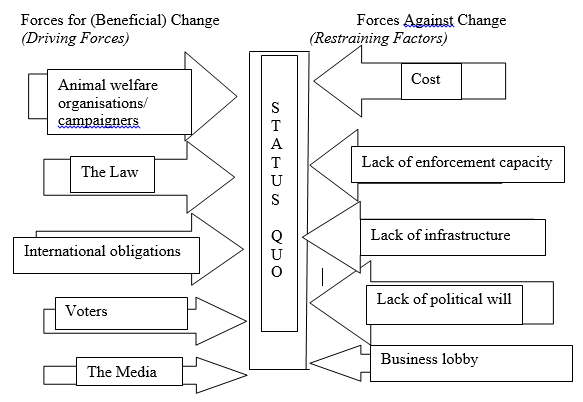
8. Power Mapping - Venn Diagram

Category:
Optional
Description and Purpose:
This is a stakeholder mapping tool that shows the key organizations and individuals involved in an advocacy issue, together with their relationships. Also knows as a Chapatti Diagram.
Method:
First ask the group to identify key organizations and individuals involved in the advocacy issue. Record these on a list.
Then draw or cut out a circle (or other shape) for each organization or individual. Bigger circles indicate more important stakeholders.
The circles are labelled.
If your issue is centered on government policy, then you can make government a central block of the diagram (e.g. represented by a different shape, color or block).
Next, the group identifies the degree of contact and overlap between each circle. Overlap occurs if one individual or institution asks or tells another to do something or if they have to cooperate in some way. Arrange as follows:
- Separate circles = no contact (or no meaningful contact)
- Touching circles = limited contact (e.g. information passes between institutions)
- Small overlap = some co-operation in decision making
- Large overlap = considerable co-operation in decision making
Draw the diagram first in pencil (or on a computer) and adjust the size or arrangement of circles until the representation is accurate. Alternatively, use lengths of string – these can be expanded or contracted until the right size is agreed. A reproduction of the string/paper/pencil circles ensures a permanent record. Secondary sources, group interviews or key informants can be used to validate information.
When you write up, you can add color-coding to indicate allegiances or categories.
The process of forming a diagram gives rise to useful observations and discussions.
A simple example follows:
The example given in this tool helps to provide important contextual information, such as the way in which research underpins decision-making (which is an area in which civil society can be weak – especially the funding of original research). Also, the link between service delivery and advocacy (where the close contact can help with ongoing advocacy, but also brings its own restraints in terms of adversarial advocacy – for fear of losing contracts and jobs).
7. Other Player Analysis

Category:
A Primary Tool
Description and Purpose:
This tool is a matrix that can be used to consider other organizations working in your field, and the nature of your relationship with them on your advocacy issue.
Method:
Map each of the important organizations working in your field in the grid.
Use this as a starting point to assess how and what they are doing.
Consider and categorize the nature of your current relationship with them.
Then, make informed choices about the type of relationship you should develop with them in the future.
As well as helping you to understand the other ‘players’ in the field, this should help you to consider how to avoid duplication, and to fill gaps in the ‘market’. In particular, which organizations you should try to prioritize for further development.
You may consider including:
- Other major animal welfare players (competitors/collaborators, national/international)
- The positioning of your organization in the wider movement.
- Whether you should adopt a competitive or collaboration strategy?
- Different forms of co-operation (e.g. joint projects, networks, coalitions and affiliations etc.)
- How full is the ‘market’ (will you be duplicating the work of others, of is there a real need for your advocacy)?
6. Allies and Opponents Matrix

Category:
Recommended
Description and Purpose:
This tool is a matrix that can be used to categorize the allies and opponents of your advocacy issue. It helps to identify your main allies and opponents, and those whose neutral position make them targets.
Method:
Consider and categorize the allies and opponents of your advocacy issue using the following matrix. Write the name of the individual or name of the organization on a post it note and plot them on the chart according to your perception of their attitude towards and influence over the issue you intend to advocate on.
Opponents: Individuals or organizations who may oppose the advocacy campaign because they may be impacted negatively by the changes advocated, because of disagreement about underlying values or merely because they may lose face.
Allies: Beneficiaries, individuals or organizations who will directly benefit or who can be persuaded to support your advocacy effort because of sympathetic concerns and similar values.
Targets: Individuals or organizations that have the power to effect the policy change or change in implementation of a policy or practice that is outlined in your advocacy objective.
Use this sorting process as a vehicle for discussion. It is very possible that some individuals within the same organization may be allies and others may be neutral or opponents, and that their position may change over time (perhaps as a result of your advocacy!)You can use the matrix to discuss whether the assessment of main allies, targets, and opponents and neutral players is correct, and move your post it notes around accordingly. There may be factors that influence this analysis (e.g. reasons behind neutrality that would make it a waste of effort to try to influence).
Keep for consideration in the strategic planning process.
From the matrix, you can identify which of the following five influencing strategies may be most appropriate:
- Build alliances (with allies)
- Persuading the stakeholder that the issue is important (mainly for allies with high influence but low interest)
- Persuading the stakeholder that your position is right (mainly for influential neutrals, targets and soft opponents)
- Helping to increase the influence of the stakeholder (mainly for allies with low influence)
- Reducing the influence of the stakeholder (mainly for opponents with high influence)
You will need to prioritize the stakeholder groups you can target, and plan strategically according to available human and financial resources.
5. Decision and Influence Mapping

Category:
Recommended
Description and Purpose:
This tool helps to map and analyze decision-makers and their sources of influence. Influence Mapping builds naturally on Stakeholder Analysis (and, to a degree, has similarities with the drivers or influences identified in a Force Field Analysis).
Method:
Construct and influence map or pyramid.
To do this, you need to be clear about the policy issue or change being analyzed and single out those in high positions of power. Then, differentiate between the decision-makers who have the actual responsibility to make the decisions in a specific policy area, and their opinion-leaders who can influence them or lead their opinion, and who are generally more accessible.
Every policy-maker depends on a group of advisors or specialists without whom they cannot operate. They are also accountable to, a wide group of interest groups, constituencies and lobbies. Further, they may be influenced by the nature of the information and research they receive, how it is reported in the media, the political regime, not to mention their own beliefs and ideologies. It is often helpful to map the information as a pyramid of actors and influences.
You can separate actors and other (more general) influences (e.g. by color coding or different arrows).
Discuss this as it is under construction. Which actors or influences would be difficult to convince on your issue, and why? Which may be easier to approach, and could be effective influences? Bring out interesting and new angles and approaches – for example, by linking your issue with their priority concerns.
You could try brainstorming the key individuals and institutions that carry the influence (e.g. specific people, newspapers, veterinarians, animal behaviorists, farmers etc.). This allows the group to analyze possible influence channels.
Once key channels have been identified the group should analyze their position on the topic, their key motives and their accessibility. Are they a supporter, an ally or uncommitted? Sometimes they can have a different status on different issues. What are their interests and motives for a particular position on the issue? What is their agenda, either stated or implicit? What drives them to take this position, and what constraints do they face that might make it difficult for them to move from this position. This may be ideological or personal, or it could be cultural or social. It might be financial (e.g. for monetary gain) or it may be political, based on the views of their interest groups, supporters, patrons and voters, the constituents who give them their position of power. Finally assesses how easy it will be to gain access and present the evidence or case.
See below for an example:
You may also find it useful to research and complete the following information for each of the major institutions, organizations of agencies involved.
| Main institutions, organizations, or agencies | Most important decision-makers | Their beliefs on issue | Their interests and agendas | Major sources of influence | Scope for positive influence on this issue? | Resources |
Adapt the criteria to suit your own purposes, if necessary.
If you add contact details, you can then keep this as a permanent record (and update as new information is received).
It can also be used as a strategic planning or activity planning tool.
4. The 'Context, Evidence, Links' Policy Framework

Category:
Recommended (depending on need)
Description and Purpose:
The below ‘context, evidence, links’ model was designed as a theoretical model to highlight to researchers the different factors that are important in the policy process. However, it also lends itself well to a project planning framework, and has been adapted for this purpose in the grid below: ‘How to influence policy and practice’.
Method:
The below model has been adapted to provide easy-to-follow guidance in the grid below it.
How to Influence Policy and Practice:
| What researchers need to know | What researchers need to do | How to do it |
Political Context:
|
|
|
Evidence:
|
|
|
Links:
|
|
|
Adapted from Tools for Policy Impact: A Handbook for Researchers Overseas Development Institute (ODI)
3. Research Case Studies

Category:
Recommended (but feel free to adapt content to suit your purposes)
Description and Purpose:
Case studies can be prepared as part of advocacy research. Their purpose is to provide true stories to demonstrate the impact of a problem and provide information to assist analysis. They should be compiled in a systematic way in order to be credible and useful.
Method:
Investigations
Undercover investigations can be used, following research, to capture the actual situation visually. This is often useful if the authorities are in denial about the facts, or do not want the media and public to see and understand the extent of the problems.
Focus Group Discussions
Discuss animal welfare problems in relevant focus groups (e.g. farmers, producers, animal behaviorists, veterinarians etc.). A range of views, knowledge and perceptions can be gained, which improves understanding.
Individual Case Studies
Whilst background information can be collected in advance, individual case studies can be carried out by observing individual animals in certain situations, and recording details meticulously (both photographically and by written and timed observations.
Situational Case Studies
Certain situations can also be examined and researched meticulously. For example, stray control problems can be examined using area maps (sectioned), population counts/demographics, male/female ratios, birth and health records, welfare problems etc.
Benefits
Case studies are useful background for strategic advocacy planning, as they help you to understand the actual situation you are dealing with. Case studies encourage integrated thinking and awareness of the complexities of real life situations. They can help to encourage focused discussions about the problem and potential solutions. Visual evidence is a useful focus for advocacy work, and can be invaluable in raising media attention. They can also help with public awareness and education, as actual stories make more impact than cold facts.
Advocacy Analysis Tool Contents

1. Issue Choice Matrix
2. Causal Mapping or Problem Tree Analysis
3. Research Case Studies
4. The ‘Context, Evidence, Links’ Policy Framework
5. Decision and Influence Mapping
6. Allies and Opponents Matrix
7. Other Player Analysis
8. Power Mapping - Venn Diagram
9. Force Field Analysis
10. Creative Drawing
11. PESTLE – External Analysis
12. SWOT Analysis
13. Advocacy Self Assessment
14. Change Management Iceberg
15. Pathways of Influence
16. Strategies to Counter Power Blocks
17. Stakeholder Analysis
18. Johari’s Window
19. Audience Prioritization Matrix
20. Involvement of Grassroots Groups
21. Systems Mapping of Targets
22. Audience Analysis
23. Risk Analysis
24. The Bridge
25. Approaches for Effective Policy Engagement
26. Six Thinking Hats
27. Log Frame
28. Managing Coalitions
29. Effective Meetings
30. Successful Media Coverage
31. Writing a Press Release
32. ‘Letters to Editors’ & Opinion Articles
33. Media Interviews
34. Gantt Charts
35. Critical Path Analysis and PERT
36. Campaign Tactics
37. Top Tips for Lobbying
38. Communication Tips for Public Speaking or Negotiating
39. Making Presentations
40. Negotiation Technique Tips
41. Advocacy Outcomes & Achievements
42. Advocacy Evaluation Case Study
43. Tips for Evaluating Advocacy
Module 8: Top Tips

- Before designing your M&E system ensure that you are clear about the changes you are trying to achieve - and how social change can be brought about in an enduring way.
- Develop your own, locally appropriate and useful system of M&E, and build this into your advocacy plan – whilst still following general M&E guidance.
- The purpose of M&E is to enable animal welfare organizations to review their advocacy experiences and to use this learning to improve their advocacy work – this means that honesty and transparency should be valued.
- Design a clear and simple monitoring system to ensure that your activities are contributing to your agreed objectives, and to ensure you have a record of any outcomes – intended or unintended.
- The Logframe can be a very valuable tool for summarizing your objectives (see Tool 27).
- When carrying out an evaluation, review outcomes & achievements (or changes), your processes, and lessons learned.
- Develop your indicators carefully to reflect the real value of your advocacy work, including aspects that are important to your organization or coalition/alliance (such as capacity building and relationship development).
- Record and discuss all of your outcomes – both the intended and unintended.
- Assess any relevant changes in the external or policy environment, and think about what your response to these changes should be.
Further Resources

Websites
World Animal Net (WAN) Animal Protection Society Resources: Continuous Improvement
ODI: A Guide to Monitoring and Evaluating Policy Influence
World Bank: Making Monitoring & Evaluation Systems Work
Aus Aid: Guidance for M&E on Civil Society Programmes
Books
The Fifth Discipline: The Art and Practice of the Learning Organisation
By: Peter M. Senge
Publisher: Bantam Doubleday Dell Publishing Group
ISBN: 0385260954
Ten Steps to a Learning Organisation
By: Peter Kline, Bernhard Saunders
Publisher: Great Ocean Publishers
ISBN: 0915556324
50 Ways Towards a Learning Organisation
By: Andrew Forrest
Publisher: Spiro Press
ISBN: 1858355990
The Goal: A Process of Ongoing Improvement
By: Eliyahu M. Goldratt, Jeff Cox
Publisher: North River Press
ISBN: 0884271781
The Kaizen Blitz
By: Anthony C. Laraia
Publisher: Jon Wiley
ISBN: 0471246484
Kick Down the Door of Complacency: Seize the Power of Continuous Improvement
By: Charles C. Harwood
Publisher: St Lucie Press
ISBN: 157444168X
Kaizen and You: Personal Success Through Continuous Improvement
By: Igor Popovich
Publisher: Management Books 2000
ISBN: 1852522615
The Ever-changing Organisation: Creating the Capacity for Continuous Change, Learning and Improvement
By: G.R. Pieters, D.W. Young
Publisher: St Lucie Press
ISBN: 1574442627
Creating a Learning Organisation (50-minute Series)
By: Barbara J. Braham
Publisher: Crisp Publications Inc
ISBN: 1560523514

